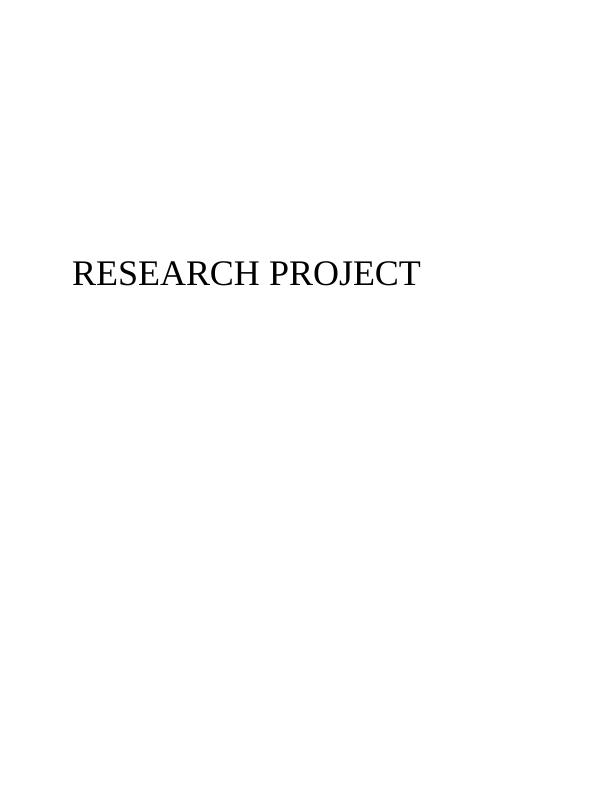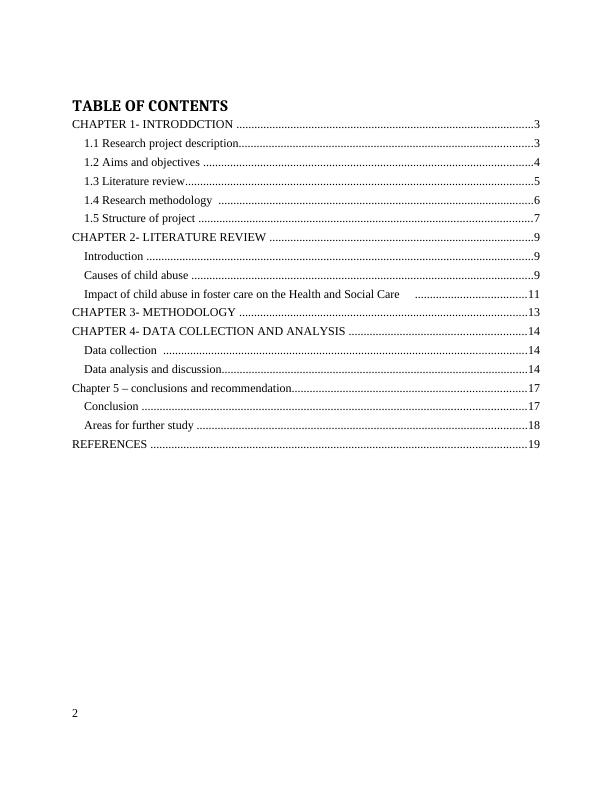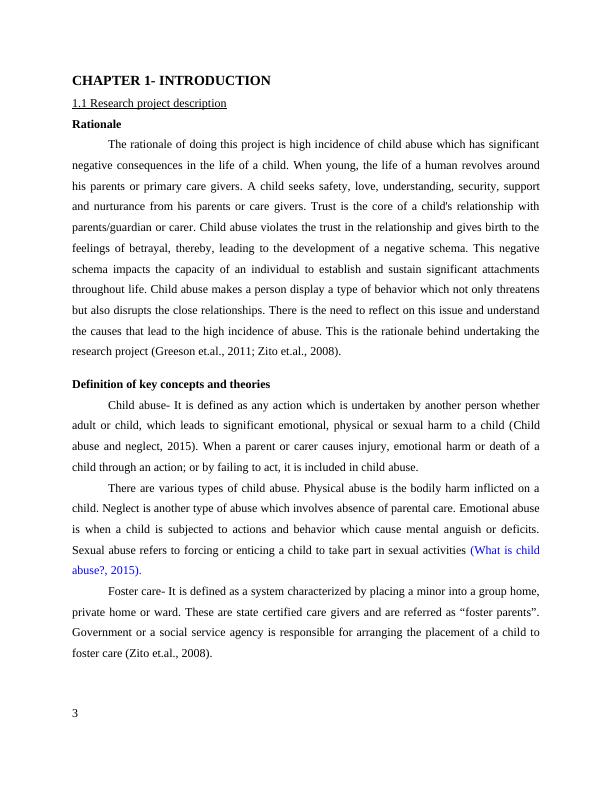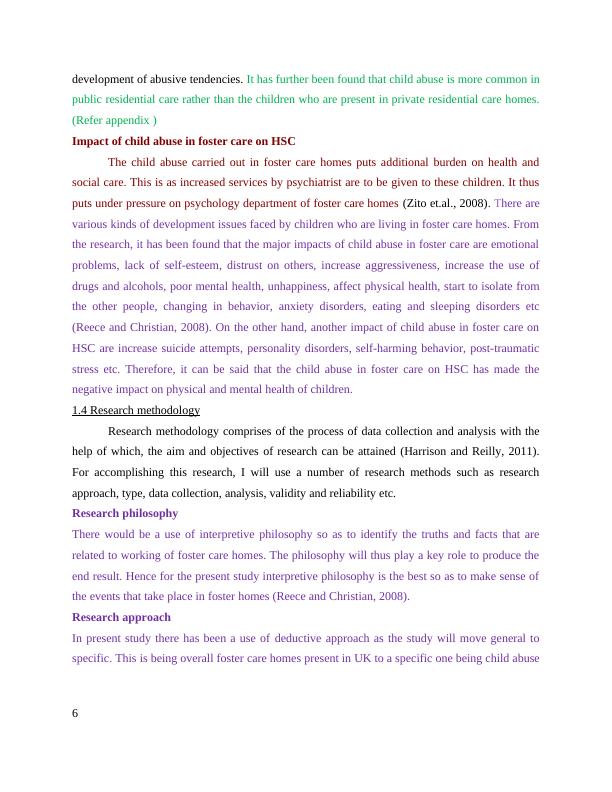Data Collection Analysis Assignment
28 Pages2829 Words164 Views
Added on 2019-12-03
Data Collection Analysis Assignment
Added on 2019-12-03
ShareRelated Documents
RESEARCH PROJECT

TABLE OF CONTENTSCHAPTER 1- INTRODDCTION ...................................................................................................31.1 Research project description..................................................................................................31.2 Aims and objectives ..............................................................................................................41.3 Literature review....................................................................................................................51.4 Research methodology .........................................................................................................61.5 Structure of project ...............................................................................................................7CHAPTER 2- LITERATURE REVIEW ........................................................................................9Introduction .................................................................................................................................9Causes of child abuse ..................................................................................................................9Impact of child abuse in foster care on the Health and Social Care .....................................11CHAPTER 3- METHODOLOGY ................................................................................................13CHAPTER 4- DATA COLLECTION AND ANALYSIS ...........................................................14Data collection .........................................................................................................................14Data analysis and discussion......................................................................................................14Chapter 5 – conclusions and recommendation..............................................................................17Conclusion ................................................................................................................................17Areas for further study ..............................................................................................................18REFERENCES .............................................................................................................................192

CHAPTER 1- INTRODUCTION1.1 Research project descriptionRationaleThe rationale of doing this project is high incidence of child abuse which has significantnegative consequences in the life of a child. When young, the life of a human revolves aroundhis parents or primary care givers. A child seeks safety, love, understanding, security, supportand nurturance from his parents or care givers. Trust is the core of a child's relationship withparents/guardian or carer. Child abuse violates the trust in the relationship and gives birth to thefeelings of betrayal, thereby, leading to the development of a negative schema. This negativeschema impacts the capacity of an individual to establish and sustain significant attachmentsthroughout life. Child abuse makes a person display a type of behavior which not only threatensbut also disrupts the close relationships. There is the need to reflect on this issue and understandthe causes that lead to the high incidence of abuse. This is the rationale behind undertaking theresearch project (Greeson et.al., 2011; Zito et.al., 2008). Definition of key concepts and theoriesChild abuse- It is defined as any action which is undertaken by another person whetheradult or child, which leads to significant emotional, physical or sexual harm to a child (Childabuse and neglect, 2015). When a parent or carer causes injury, emotional harm or death of achild through an action; or by failing to act, it is included in child abuse. There are various types of child abuse. Physical abuse is the bodily harm inflicted on achild. Neglect is another type of abuse which involves absence of parental care. Emotional abuseis when a child is subjected to actions and behavior which cause mental anguish or deficits.Sexual abuse refers to forcing or enticing a child to take part in sexual activities (What is childabuse?, 2015). Foster care- It is defined as a system characterized by placing a minor into a group home,private home or ward. These are state certified care givers and are referred as “foster parents”.Government or a social service agency is responsible for arranging the placement of a child tofoster care (Zito et.al., 2008). 3

Background to research problemAccording to the estimation of NSPCC, over half a million children experience childabuse in UK every year. In Britain, one in every 100 children is abused every year. According toDugan (2014), findings regarding child abuse in foster care in UK are shocking. When abuseallegations and outcomes were tracked between years 2009 to 2012, it was found that there arearound 450 to 550 cases of proven abuse in foster care. More than 88 per cent of abuse in fostercare is perpetrated by the carers (Dugan, 2014). Physical harm was caused to a child in morethan one third of cases. Similar number of cases was of emotional abuse. Further, approximately11 per cent of children were sexually abused. In UK, more than 60 per cent of abuse victims aregirls with a mean age of 9 years. Overall in UK, every year, around 2000- 2500 allegations ofabuse of children are found (Dugan, 2014). However, the situation is different in Romania. Banon contraception led to skyrocketing birth rate. However, the poor families abandoned theirchildren to large state institutions. This made 'neglect' as a big problem in Romania which led toabuse of children in other care institutions. But, it was found that children in foster care inRomania developed in a better manner as compared to other institutions. Considering thenegative impacts of child abuse, this issue is a serious concern in a developed nation like UK.Thus, the research problem is the high incidence of child abuse in foster care in UK and reasonsbehind it. (Weir, 2014)1.2 Aim and objectivesThe Aim of my research project is:To critically review the high occurrence rate of child abuse in foster care in UK.The Objectives of my research are:To analyze the etiology of child abuse in foster care in UK.To compare the incidence of child abuse in foster care in UK vs Romania.To outline the impact of child abuse in foster care on the Health and Social Care.4

1.3 Literature reviewReece and Christian, (2008) asserted that many children found separation from parents asdetrimental. It is obvious that stability is not provided by foster care to the children. Adjustmentsneed to be made by the child regarding new way of life in foster care environment (Reece andChristian, 2008). It can be analyzed that the possible issue with foster care is that it is difficult forchildren to adjust according to new surroundings, different lifestyles, new neighbors and friends.As per the views of Herrenkohl et.al., (2008), neglect is the most reported abuse in foster care.This is often faced by immigrant children who find it stressful to adjust to a new culture(Herrenkohl et. al., 2008). However, Pereda et.al., (2009) argue that the issue with foster care isthat children are made to bounce around different placements which affect their education andother areas of development and growth (Pereda et.al., 2009). Pipe et.al., (2013) analyzed that caregiver factors are associated with child abuser infoster care (Pipe et.al., 2013). According to Bruskas (2008), personality characteristics andpsychological well being of care giver is a risk factor for child abuse. Low self-esteem andexternal locus of control lead to neglect and physical abuse. Some caregivers, who have a historyof maltreatment, abuse the children (Bruskas, 2008). But, Doyle, (2008) asserts that there is anincreased risk of child abuse if the caregiver himself has witnessed abuse when he was a child.Another cause of child abuse is that some carers are substance abusers and have lack ofappropriate knowledge regarding child development (Doyle, 2008). These factors place the childat the risk of abuse. Apart from this, there are certain childhood risk factors which can beconsidered as the causes of child abuse in foster care. According to Price et.al., (2008),disabilities in children lead to their abuse in foster care. Infants are more dependent on theircarers which makes them even more prone to abuse. Also, children with behavioral andemotional difficulties are more vulnerable to abuse in foster care. (Price et.al., 2008). According to Brook and McDonald, (2009), foster homes are designed for protectingchildren who are abused or neglected. However, child abuse still takes place within foster homes.In UK, foster care has always been considered as an option (Brook and McDonald, 2009). Infoster care, abuses are sometimes caused due to difficult and stressful working environments.Also, there are situations when the carers are given least training and hardest schedules. Lesspayment and undesirable working conditions makes the carers frustrated which leads to the5

development of abusive tendencies. It has further been found that child abuse is more common inpublic residential care rather than the children who are present in private residential care homes.(Refer appendix ) Impact of child abuse in foster care on HSCThe child abuse carried out in foster care homes puts additional burden on health andsocial care. This is as increased services by psychiatrist are to be given to these children. It thusputs under pressure on psychology department of foster care homes (Zito et.al., 2008). There arevarious kinds of development issues faced by children who are living in foster care homes. Fromthe research, it has been found that the major impacts of child abuse in foster care are emotionalproblems, lack of self-esteem, distrust on others, increase aggressiveness, increase the use ofdrugs and alcohols, poor mental health, unhappiness, affect physical health, start to isolate fromthe other people, changing in behavior, anxiety disorders, eating and sleeping disorders etc(Reece and Christian, 2008). On the other hand, another impact of child abuse in foster care onHSC are increase suicide attempts, personality disorders, self-harming behavior, post-traumaticstress etc. Therefore, it can be said that the child abuse in foster care on HSC has made thenegative impact on physical and mental health of children.1.4 Research methodologyResearch methodology comprises of the process of data collection and analysis with thehelp of which, the aim and objectives of research can be attained (Harrison and Reilly, 2011).For accomplishing this research, I will use a number of research methods such as researchapproach, type, data collection, analysis, validity and reliability etc. Research philosophyThere would be a use of interpretive philosophy so as to identify the truths and facts that arerelated to working of foster care homes. The philosophy will thus play a key role to produce theend result. Hence for the present study interpretive philosophy is the best so as to make sense ofthe events that take place in foster homes (Reece and Christian, 2008). Research approach In present study there has been a use of deductive approach as the study will move general tospecific. This is being overall foster care homes present in UK to a specific one being child abuse6

End of preview
Want to access all the pages? Upload your documents or become a member.
Related Documents
Health and Social Care (HSC) Management Assignmentlg...
|65
|17941
|37
Children being exposed to domestic violence - child abuselg...
|11
|3449
|287
Impact of Domestic Abuse on Children and Social Work Interventionslg...
|22
|5136
|1
Domestic Violence and Child Abuse: Implications for Healthcare Workerslg...
|7
|2462
|216
Reasons for Child Abuse: A Public Health Perspectivelg...
|7
|1999
|446
Fundamentals of Evidence based practicelg...
|12
|453
|49
